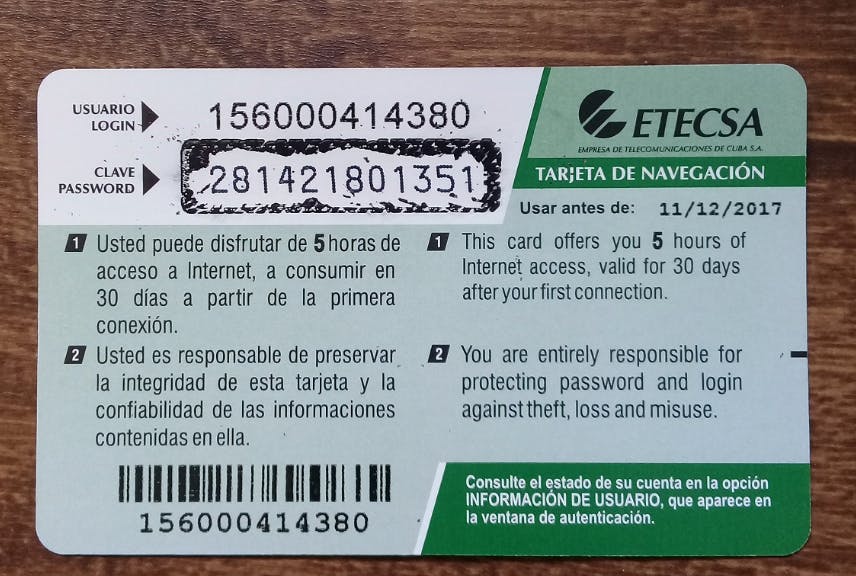How I Put Taxi Drivers in Cuba “Online” Without the Internet

Hacking the internet in a country where the internet doesn't exist.
Cuba was, until 2016, an island in the Caribbean where "internet for the masses" didn't exist.
Before 2016, Internet was available only for state institutions (like universities), some workers at state-run companies and for selected people like some journalists, artists or state officials.
Despite this, I was able to set up a business where I connected taxi drivers inside the island who worked in tourism but didn't have Internet with potential customers (travelers coming to Cuba) outside of the island interested in booking transportation in advance.
Because I didn't have much access to Internet either, I had to create something that allowed me to run the business without full-time Internet access. How I did it? Email.
But first, let’s backtrack. I started building this solution in 2014. For context, it’s worth noting that Cuba has only one telecommunications provider, ETECSA. All Phone calls, SMS and internet go through it. In 2014, ETECSA launched an email platform called Nauta, which could be accessed via mobile data through an APN for Cuban phones. People in Cuba could now check and send emails from their phones! But still, no Internet.
In 2016, ETECSA started to deploy Wi-Fi equipment in some areas all over the island (parks, hotels, etc). This was the first time anyone could connect to the internet if they wanted to (and could afford it). To connect, locals had to go to a designated Wi-Fi zone and were charged by the hour for internet access. Internet pricing started at $4.50/hour of connection, but gradually decreased to what it is now $1/hour. You connect by buying a card like this:

In November 2017, ETECSA started deploying Internet at people's homes via ADSL modems. The lowest price for a package of 30 hours/month was $15 ($0.50/hr). In December 2018, ETECSA started to provide mobile internet. The lowest price is $7/600 MB of data, which lets you connect virtually from anywhere at anytime.
So up until 2016, there was basically no way that someone could connect with a person outside of Cuba easily (unless through a very expensive phone call or text), and it still is done very expensively ($1/hour) and uncomfortably (you have to be at a very crowded public Wi-Fi zone).

Accordingly, the first "portable connection to the outside" we had was email in our phones via the Nauta platform. And that was the keystone for my project.
I launched YoTeLlevo in December 2014, back when there was no Internet.
This was the same year ETECSA launched Nauta email. Coincidence? 😉
When ETECSA launched the Nauta email platform in 2014, I saw an opportunity to use email as a transport for data from and to an Internet server.
Even if we didn't have Internet, a backdoor was opened, and it was email.
NOTE: I wasn't the only one noticing this opportunity. Other apps appeared (chat apps mostly) that used Nauta email to transport data.
Here’s how I did it:
Initial approach
- My original idea was to have an Internet server and a website hosted on the server — this would be a battle in itself, but could be done.
- The website would accept requests from people traveling to Cuba who wanted to arrange transportation by taxi in the island in advance.
- The website would immediately send each request to multiple drivers via email. Each driver would receive all the data of the request in their inboxes, which could be checked on the phone, along with the customer's email address.
- The drivers could start a conversation with the potential customers by forwarding the email to the customer's email address and continuing from there.
My business strategy
- I didn't have Internet myself (well, only very sporadically), so I could not work as a middle man and talk to customers. Sending the requests to the drivers directly would detach me from having to being available all the time.
- Even if I could be available all the time (using email), I wouldn't be able to cope with a lot of requests without hiring more people. So I opted to distribute the effort of arranging the trips among the drivers themselves.
- With this system, I could focus my efforts on things like marketing and finding more drivers, instead of drowning in operational stuff everyday.
Why it worked for the drivers
- They had access to a new channel that brought customers to them, without ruining any other ways they acquired customers (like waiting parked on the streets around hotels).
- They could arrange trips while being anywhere, because they had email on their phones and email was their interface for YoTeLlevo. This was new for them! They could even arrange the next trip while they were far from home doing another trip.
- They could set the prices themselves, negotiate the terms and go to specifics if needed without anyone in the middle thinking for them or inflating prices.
For the drivers, it was like someone was sending them leads all the time in a very convenient (and new) way. Remember, there was still no internet at this time.
Improving on the initial approach
However, there was a problem with this initial approach: I would never know if the system was effective or not. Did customers actually hire the drivers?
Besides, if I wanted to earn something from this, I had to be able to know if some of these requests and negotiations had come to a good end and turned into an actual job for the drivers.
I needed to see the conversations that were taking place.
I went ahead and hacked a little system to be able to see what was happening in the negotiations so I could ask for a commission to each driver that was hired after the service took place.
The system was simple:
- I wouldn't send the customers' email addresses to the drivers anymore. Instead, each notification email from my server to the drivers carried in the subject a unique identifier for the conversation.
- Each driver would reply to that email without modifying the subject of the email, which guaranteed that the identifier would not be lost before arriving back at my server. That email then went directly to my server instead of going to the customer's inbox.
- When the email arrived at my server, I would check the identifier (automatically, of course), and* *stored the message in the corresponding conversation in my database. I would then re-route it to the customer's email address.
- The customer would then receive the email sent by the driver, which also included the identifier on the subject, and would do the same the driver did: reply to the email without modifying the subject. The server would do the same and re-route the email back to the corresponding driver.
Everything went through my server. Now I could see all the details. It worked like a chat system, but the transport was email.
Why this worked: I could check on the conversations at any moment without having to keep up in real-time, since the messages were recorded on my database every time they went through my server. I was also able to "polish" each email customers received from the drivers once they went through my server. I attached a small picture of the driver's face (an avatar) and a link to the driver's profile. The customers received a nice looking email with information upfront (the driver's avatar) and a link to see more. I could also see if a customer decided to hire a driver through my admin panel, so I could ask for a commission to the driver after the service was done. As a plus, I kept customers coming to my website when they visited the driver's profiles via the link I sent.
And for the drivers
Having pictures on my website solved a huge financial problem for the drivers. To use Nauta email, people had to pay ETECSA $1 for each MB transferred. So any image a driver sent could potentially cost a ton of money. With my system, drivers didn't have to attach pictures every time a customer asked (customers would ask for a picture all the time) — they already had a profile with pictures on our website and we sent a link to the customers automatically, so they could see the pictures there.
The drivers' profile pages were also personal pages that displayed pictures of them and their cars. They could use their profile pages as a homepage for their own services, and we later used them to add reviews from previous customers.
As I could "polish" each email, the drivers received emails with all the messages in the conversation displayed (ahem) beautifully, instead of relying in the way their email client organizes previous messages. This also made keeping up with the messages in a conversations easier for the drivers.
Launching
This system was up and running by December 2014, and launched right away with three drivers in Havana and a few in other cities. It may seem like a very 1995 system, but it worked great for the drivers as it bypassed Cuba’s lack of an online presence at the time.
From me, it essential required time and effort, and an initial payment for the first year of hosting by a relative of mine who lives abroad.
ETESCA opening up an email platform to Cubans was key too, because it was them possible to use email to transport data from one point to another (i.e. from a client to a server).
Today, YoTeLlevo still exists and is a very active community of private drivers for tourism in Cuba.
And we still use email. But we’re now working on a mobile app too. 😉
Comments (9)
Marianela Avila@marianela_avila
Super
Share
Ingenious 👍
Wow, what an inspirational story. Congratulations!
doing without
More stories

Keegan Walden · Makers · 7 min read
The inner work of startup building

Calvin Chen · Makers · 7 min read
Suffering = Growth
Sumanyu Sharma · News · 4 min read
Can LLMs find bugs in large codebases?

Sarah Wright · News · 3 min read
What AI tech leaders say about AGI


